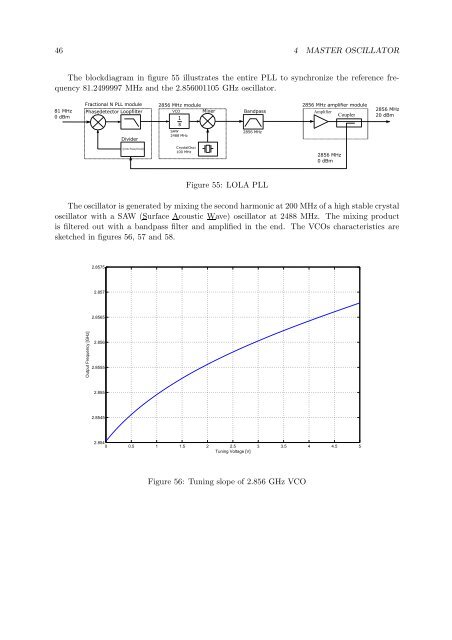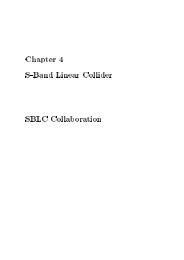Stability of the Master Oscillator for FLASH at DESY
Stability of the Master Oscillator for FLASH at DESY
Stability of the Master Oscillator for FLASH at DESY
Create successful ePaper yourself
Turn your PDF publications into a flip-book with our unique Google optimized e-Paper software.
46 4 MASTER OSCILLATOR<br />
The blockdiagram in figure 55 illustr<strong>at</strong>es <strong>the</strong> entire PLL to synchronize <strong>the</strong> reference frequency<br />
81.2499997 MHz and <strong>the</strong> 2.856001105 GHz oscill<strong>at</strong>or.<br />
Figure 55: LOLA PLL<br />
The oscill<strong>at</strong>or is gener<strong>at</strong>ed by mixing <strong>the</strong> second harmonic <strong>at</strong> 200 MHz <strong>of</strong> a high stable crystal<br />
oscill<strong>at</strong>or with a SAW (Surface Acoustic Wave) oscill<strong>at</strong>or <strong>at</strong> 2488 MHz. The mixing product<br />
is filtered out with a bandpass filter and amplified in <strong>the</strong> end. The VCOs characteristics are<br />
sketched in figures 56, 57 and 58.<br />
Output Frequency [GHz]<br />
2.8575<br />
2.857<br />
2.8565<br />
2.856<br />
2.8555<br />
2.855<br />
2.8545<br />
2.854<br />
0 0.5 1 1.5 2 2.5<br />
Tuning Voltage [V]<br />
3 3.5 4 4.5 5<br />
Figure 56: Tuning slope <strong>of</strong> 2.856 GHz VCO





